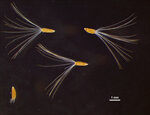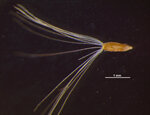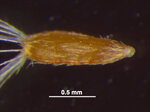Taxonomy
Conyza sumatrensis (Retz.) E.Walker, J. Jap. Bot. 46(3): 72. 1971.Common synonyms
Erigeron sumatrensis Retz. Observ. Bot. (Retzius) 5: 28. 1788. According to current view this species includes what was formerly treated separately as Conyza albida Willd. ex Sprengel and Conyza floribunda (HBK), and accordingly the synonym Erigeron floribundus .
Conyza is not distinct from Erigeron, and the name cited here as a synonym would be more scientifically correct. The species is retained here as a Conyza merely to avoid confusion.
Common name
Tall fleabane, broad-leaved fleabane, Guernsey fleabane
Description
Propagule or dispersal unit is the fruit with pappus. Fertile part 1-1.5 mm long, 0.2-0.6 mm wide, in side view widest in upper part (obovoid), +/- straight, the upper (apical) end narrowing, in cross-section flattened, basal scar (carpopodium) pronounced and well-differentiated, central, beak (=thinner sterile stalk between seed and pappus) absent, wings absent, fruit surface light brown or straw or reddish to pink, smooth (except at cellular level), with simple straight hairs, thickened margin absent or present (by misinterpretation), thick margin hairs simple straight hairs, longitudinal ribs absent or present, 2, their surfaces smooth, with simple straight hairs.
Pappus type bristles / hairs, pappus elements all +/- similar, up to 2.5-4 mm long, in one row, pappus elements numerous, persistent, the individual bristles rough / serrated (barbellate), +/- equal width along length, white / translucent.
Notes: The key accommodates the interpretation of surface structures either as two longitudinal ribs or as a thickened margin. The ribs are sometimes dark reddish-brown. Unfortunately, the fruits of the various species of Erigeron / Conyza are all rather similar and hard to differentiate. Erigeron generally has an additional longitudinal rib on the fruit surface whereas Conyza generally has only the two marginal ribs or thickened margins, depending on interpretation.
Ecology
Tall annual herb, fruit wind-dispersed. Tropical to subtropical areas. Prefers areas of intermediate disturbance levels such as natural habitats, long-lived crop plantations, managed forests, orchards, rail- and roadsides.
Native range
Brazil, Bolivia, Paraguay, Uruguay, Argentina
Introduced range
Venezuela, Guyana, United Kingdom, Spain, France, Serbia, Romania, Bulgaria, Greece, tropical to southern Africa, Afghanistan, Bhutan, China, Japan, Phillipines, Sri Lanka, Malaysia, Indonesia, Papua New Guinea, Australia, New Zealand, Fiji.
Past interceptions (Australia): origins
Spain, Kenya.
Unidentified species of the same genus from United States, Mexico, Colombia, Ecuador, Argentina, United Kingdom, Spain, Belgium, France, Germany, Italy, Hungary, Slovakia, Kenya, UAE, India, China, Korea, Japan, Thailand, Indonesia, Papua New Guinea, New Zealand.
Past interceptions (Australia): commodities
Cut flowers, new vehicles, containers.
Unidentified species of the same genus in/on machinery and parts, agricultural machinery, timber pallets, containers, nursery stock, new vehicles, cut flowers, steel, fresh fruit.


